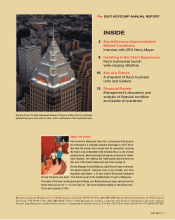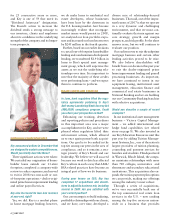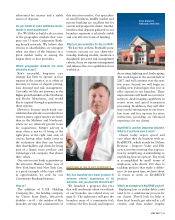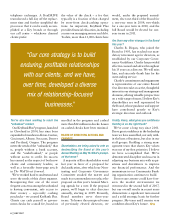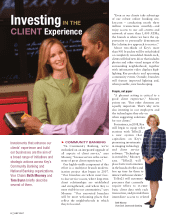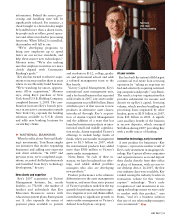KeyBank 2007 Annual Report Download - page 5
Download and view the complete annual report
Please find page 5 of the 2007 KeyBank annual report below. You can navigate through the pages in the report by either clicking on the pages listed below, or by using the keyword search tool below to find specific information within the annual report.
2007 PERFORMANCE
Henry, you indicated early last year that
2007 likely would be a tough year for
banks. It turned out to be far more chal-
lenging for the industry than anyone
might have predicted. How would you
broadly describe Key’s performance?
Looking back, 2007 can be divided
into two markedly different periods.
During the first half of the year, we
were effectively executing on our
strategy, exceeding our profit plan
and earning recognition for strong
financial results. We were on track to
achieve our third consecutive year of
record earnings. Then came serious
market disruptions, beginning in
August, that negatively affected all
financial services companies. Key’s
homebuilder portfolio and certain
types of capital markets and trading
activities were the major areas of
underperformance.
How would you characterize 2007 financial
results?
As noted, we had every intention of
achieving another record year. We are,
of course, disappointed that we did
not. However, given market condi-
tions in the second half of the year,
our 2007 results were very compara-
ble to those of our peer banks. I would
add a reminder that Key’s results in
2006 and 2005 demonstrate what we
are capable of achieving in a more
stable interest rate environment.
In 2007, we reported $5.0 billion in
revenues, a modest increase over the
previous year, and our total assets
reached $100 billion for the first time.
Still, our earnings of $941 million
fell short of our record earnings of
$1.193 billion in 2006.
How do you analyze that performance?
On a relative basis, we avoided
some of the major issues that heavily
affected others in our industry. The
strategic decisions we made in prior
years protected us to a large extent
from the more severe earnings decline
of financial institutions active in the
residential or subprime mortgage
markets, or that issued certain types
of mortgage-backed securities or
complex investment vehicles.
Though the market disruptions defi-
nitely slowed our financial momentum
in the last half of the year, and will
continue to affect us as we enter 2008,
we moved ahead with several major
projects to improve our businesses,
and adopted additional expense-
control actions at year end to sustain
our competitiveness.
Would you elaborate on Key’s strategic
decisions?
In recent years we’ve made a number
of strategic decisions regarding our
mix of businesses and loan portfolio,
including exiting the subprime home
equity and indirect automobile lending
businesses. We decided two years ago
to sharply curtail our condominium
development lending in places where
we thought the market was becoming
overbuilt. Key also has limited its
participation in large and leveraged
syndicated financing transactions.
Moreover, we have no meaningful
exposure to complex securities such
as collateralized loan obligations
(CLOs), collateralized debt obligations
(CDOs), asset-backed commercial
paper (ABCP) and structured invest-
ment vehicles (SIVs).
What were the bright spots in the company’s
2007 performance?
Commercial loan growth was solid
last year, increasing to $52.7 billion at
year end, from $48.3 billion a year ago.
Our institutional asset management
unit, Victory Capital Management,
as well as several other fee-based busi-
nesses, had favorable performances.
Excluding the impact of the sale of our
McDonald Investments branch net-
work last year, trust and investment
services income increased by 14 percent,
driven by growth in both personal and
institutional asset management income.
Key’s Board of Directors in December
increased the quarterly dividend for the
43rd consecutive year. That puts Key in
a pretty select group of American com-
panies, right?
Absolutely. Very few U.S. companies
have such an impressive record. In fact,
Standard and Poor’s tracks companies
that have increased their dividends
KEY 2007 5 3



